Odallus: The Dark Call is what you would get if you tossed a classic Castlevania game into a blender along with Berserk and added a dash of modern game design sensibilities. With its somewhat methodical approach to platforming and combat and a world divided into levels filled with branching paths and secrets, Odallus takes many of the best ideas the action platformer genre has to offer and combines them with fantastic aesthetics and a dark fantasy setting to create an incredible experience which outclasses much of the competition.
Even though it doesn’t directly take after either, Odallus proudly and blatantly displays its two main sources of influence. The Berserk side of things primarily comes into play when it comes to the story and the world design. The protagonist is a warrior named Haggis and we are first introduced to him while he is resting beside a bonfire, but it doesn’t take long before he finds himself on a journey to get revenge for the destruction of his village and, more importantly, to save his son from the clutches of a demonic cult. This is a journey through cursed lands filled with ominous stone tablets, magical red shards which make you “feel strange and uneasy” upon collecting them, and monstrous abominations. From the smallest enemies and background details to the cutscenes and dialogue, nearly everything in Odallus is carefully crafted to let players know that Haggis has chosen to raise his sword against eldritch horrors which defy mortal comprehension.

The gameplay is primarily where the Castlevania influence becomes noticeable. It’s no coincidence that the sprite for Haggis is about the same size and shape of a NES Belmont right down to the complete lack of facial features. Haggis may wield a sword instead of a whip, but his sword has some pretty decent range on it and there is a key similarity when it comes to attacking and jumping. Namely, you are committed to each of your attacks due to a noticeable delay after each slash before you can slash again and you are likewise committed to each jump due to the combination of Haggis’s somewhat large sprite size and his consistently mediocre, though not outright slow, movement speed. As I mentioned at the start of this article, the combat and the platforming don’t have such a deliberate pace to them that I’d consider them to actually be methodical, but the amount of commitment you need to place behind every action does, for example, mean that you won’t usually escape unscathed from an incoming enemy if you miss with your first slash and you’ll need to keep a constant eye out for tells in order to dodge away in time when fighting tougher foes.
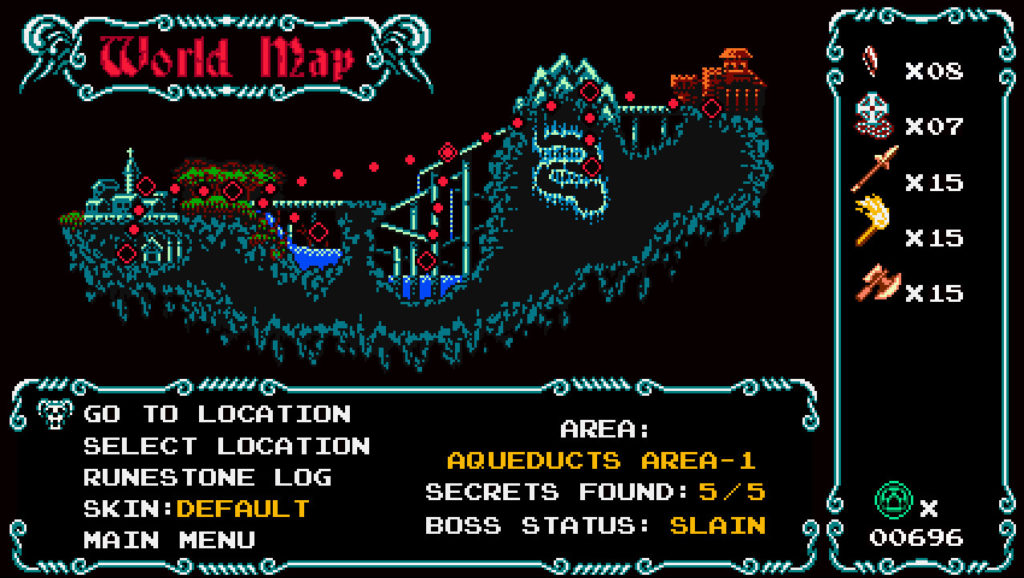
Even though the moment-to-moment pacing of Odallus is strikingly similar to that of a retro Castlevania game, there are many elements which are significantly or completely different. The level structure is a particularly important part of this game. The world is divided into nine levels, but progression is not a simple matter of traveling in a straight line from the start of the first level to the end of the last level. Specifically, there are four regions to the game plus a final area which can only be accessed once all eight of the other levels have been completed. Every region contains two levels, but the first level in each region always has two paths, one of which leads to the first level of the next region and another, secret path which grants access to the second level in the same region. You can go back to any level after beating it and you can even choose to start from the secret path if you have found it, which can considerably cut down on backtracking time; the second level in each region is never connected to anything other than the first level in the region, so every second level instead has a skull-shaped teleporter near the start which connects to an identical teleporter near the halfway point. Most levels are quite long and have plenty of hidden or otherwise optional paths within them, though simply reaching a boss is usually a fairly straightforward affair. Thus, the world being divided into levels resembles the format of a standard action platformer, but the large, branching nature of the levels and the flexible order in which you can complete the levels more closely resembles the format of a Metroidvania, so progression here is an interesting and rather unusual fusion of linear and nonlinear elements.
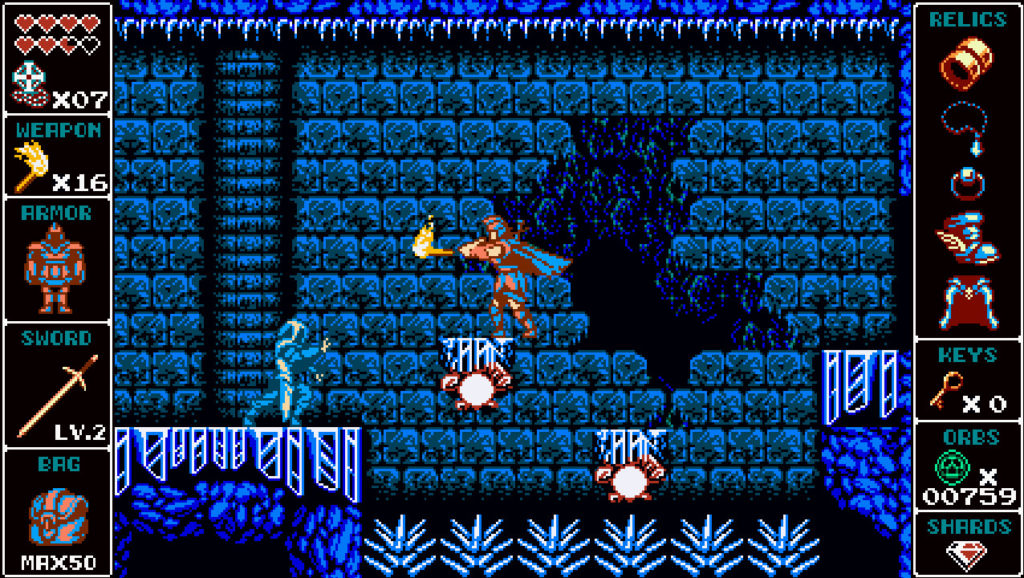
As you might have guessed from the branching nature of the level design, there are all sorts of upgrades to find scattered throughout the game. On the consumable side of things you have three subweapons which you can find by breaking jars or by buying them from a mysterious merchant who also sells healing food and extra lives. The three subweapons are an axe, a spear, and a torch and you can freely toggle between them at any time. The axe is the first of the three to appear in the game and it can be thrown in a straight, horizontal line to pierce through enemies for a handy ranged attack and it can even bounce off of solid walls to hit enemies, giving it the potential to strike an enemy once while flying forward and again on the rebound if an enemy is near a wall. Torches are more close-range weapons which Haggis tosses in a short arc towards the ground and they ignite into a trail of flames upon impact which can deal plenty of damage to large or immobile enemies and which can even break through ice blocks. Spears are probably the most difficult of the subweapons to use because they travel in an upward arc which makes them great for taking out flying enemies, but instead of creating a completely smooth arc they instead plummet straight down shortly after reaching the peak of their arc. Like torches, spears have a use outside of combat as they can hit switches in odd places and break through cracked floors which Haggis simply can’t reach with his sword. Though every subweapon has its own stock, you can find bag upgrades which each permanently increase the limit for all three subweapons by five. These subweapons make for a solid trinity as each one has a unique angle and range for its attack and there are many situations where using the right subweapon can make a huge difference.
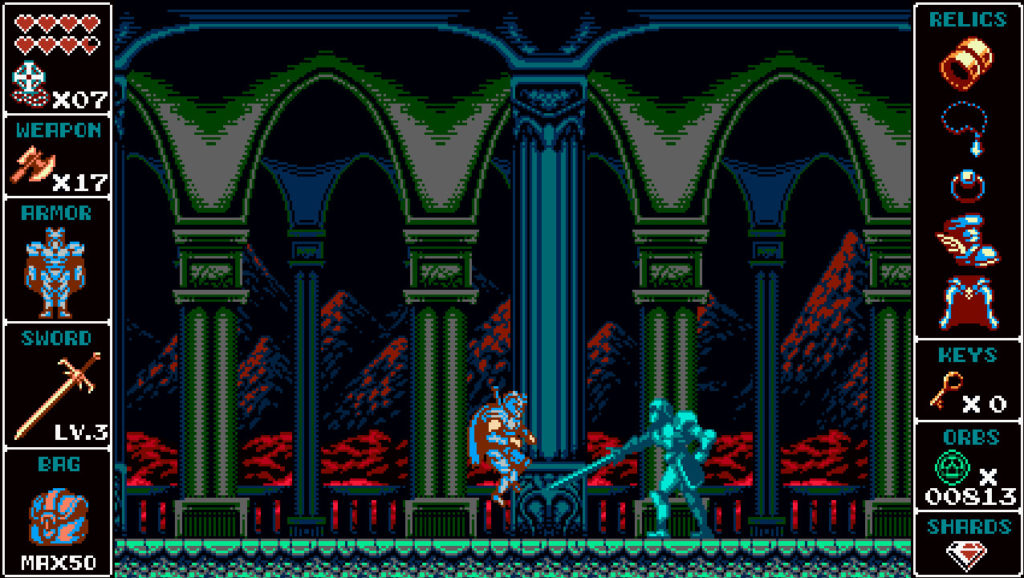
When it comes to permanent upgrades, there are quite a few beyond the bag expansions. Your health is represented by hearts and you start with four hearts, but each level other than the final one has half a heart hidden somewhere within it, allowing you to double your initial health if you find all of them. Relics are the only mandatory upgrades in the game and these are often needed in order to reach secret paths as they grant Haggis useful passive skills like a double jump and the ability to breathe underwater. Though they are not exactly upgrades, it’s worth mentioning that every level also has a floating ‘runestone’ to find, each of which contains a few lines of lore related to the history of the cult Haggis is pursuing. Other than the double jump relic, the optional upgrades you can find for your armor and your sword have the largest impact upon the gameplay. The first armor upgrade simply reduces the amount of damage you take, but the second upgrade, which is far more difficult to obtain, comes with a handy upgrade for your subweapons. As for the two swords you can find, their benefits stack to double your damage and, more importantly, your attack speed to almost completely eliminate the sense of commitment behind each strike. Between the double jump and the reduced delay between strikes Haggis becomes a far more fleet-footed fighter by the end of the game and far more powerful in general when you add in all the other upgrades.
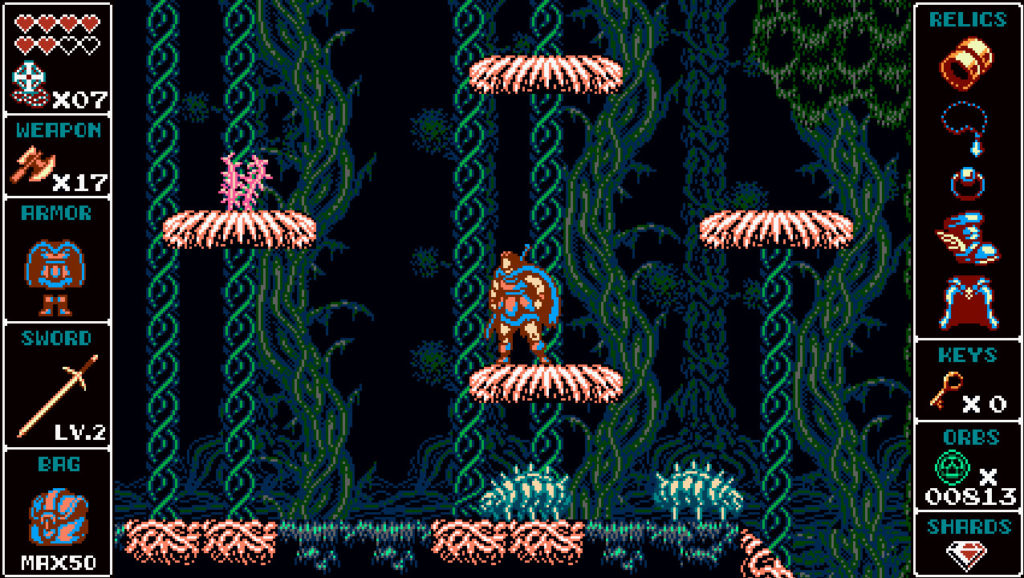
Level design is exceptionally solid across the board. there is enough variety that no two levels feel the same and even levels within the same region have significant differences, such as in the case of one pair where the first level takes place traveling across mountains while dealing with wind and icy terrain while the second level still has some ice, but it takes place in an abandoned mine complete with multiple minecart segments where you must make split-second decisions. In fact, the level variety is handled so well that the second half of every region’s second level has a completely different structure compared to the first half and often includes a significant aesthetic change. Despite the retro aesthetic and a generally high difficulty, there is never any danger of instant death. Spikes exist, but they only deal some damage if you land on them and almost every pit in the game is actually just a branching path. There are a handful of pits which are actually hazardous, namely during the minecart rides and two autoscrolling sections which take place on boats, but in these situations it’s always very clear that falling down is a bad idea and even then you still only take some damage and get teleported back to the start of the segment if you fail.

On top of the skull teleporters and the ability to start from secret paths, checkpointing is handled well in general within the levels as there are skull pillars which you will respawn at upon death once you interact with them. Individual rooms are varied as well with plenty of upward, downward, and horizontal corridors alongside a few more open spaces and the presence of some platforming puzzles adds in some variety beyond moving forward and killing enemies. Each level comes with its own unique gimmicks and enemies so you really never know what to expect next, especially since the more ‘eldritch horror’ element to the setting allows for some particularly creative enemies and areas. The only parts of the entire game which stand out to me as having not been particularly fun are the two boat segments as falling off the boat at any point puts you back at the very start of the segment and the autoscrolling nature of these challenges means you can’t make them go any faster. Thankfully, you gain access to permanent shortcuts after each boat segment so you only need to complete each of these a single time and these segments still make up a relatively small portion of the otherwise entirely fine levels which they are found in.
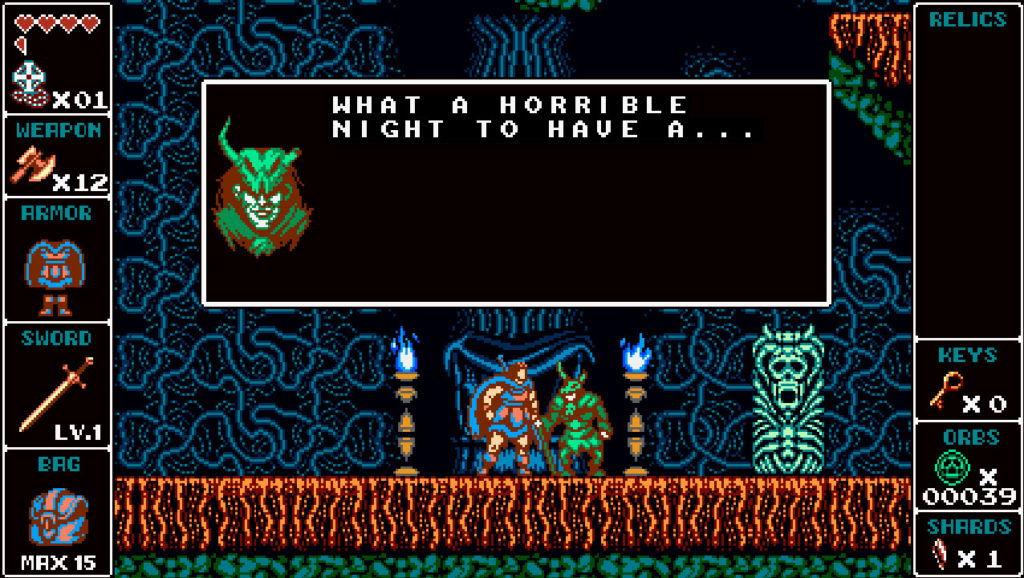
As far as difficulty goes, Odallus is balanced well. It’s definitely a challenging game, but not to a degree which feels unfair or frustrating. Running out of lives simply kicks you out of your current level and it’s an event which is unlikely to occur thanks to the healing items and extra lives the merchant sells at gradually increasing prices. The merchant is also useful when it comes to exploration as you can talk to him in each level to get clues for item locations alongside some lore and a bit of referential humor, though actually reaching optional upgrades can be quite difficult at times. Boss fights are particularly dangerous and they are where you are likely to lose most of your lives, though you can also choose to avoid some of the harder bosses until you have found plenty of upgrades so you have some real control over just how hard most boss fights actually are. For those who really crave a challenge, the Veteran Mode option in this game is no laughing matter as it rearranges the layouts for most levels, changes some item locations, and completely alters enemy placement; Veteran Mode absolutely earns its name and it’s well worth trying out after an initial playthrough.
Odallus: The Dark Call is a fantastic tribute to the past, but its more modern approach to level design and progression allows it to be equally well-suited for players seeking out more than a simple nostalgia trip. All who enjoy action platforms would do well to heed this call and give this game a try.